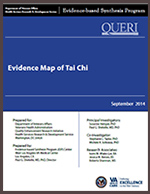
Principal Investigators:
Susanne Hempel, PhD;
Paul G. Shekelle, MD, PhD
Co-Investigator:
Stephanie L. Taylor, PhD;
Michele R. Solloway, PhD
Download PDF: Report
This evidence map provides an overview of Tai Chi research and describes its volume and focus. It combines a systematic review of systematic reviews with a scoping review for the VA priority areas pain, posttraumatic stress disorder, and fall prevention. The evidence map summarizes patient outcomes reported in reviews of studies in patients practicing Tai Chi for health-related indications. We searched PubMed, DARE, the Cochrane Library of Systematic Reviews, the Campbell Collaboration database, AMED, CINAHL, PsycInfo, Scopus, Web of Science, and PROSPERO; screened reviews of reviews; and consulted with topic experts. We used a bubble plot to graphically display the research field and summarized results narratively in an executive summary.
Tai Chi has been investigated as a treatment for a number of clinical indications. The systematic review identified 107 systematic reviews. Reviews addressing general health effects, psychological wellbeing, or interventions in older adults included between 31 and 51 randomized controlled trials (RCTs). The topic areas balance, hypertension, falls, quality of life, cognitive performance, and vestibulopathy have also been the focus of research; included reviews identified 10 or more pertinent RCTs per topic. Statistically significant effects across existing studies were reported for hypertension, falls outside of institutions, cognitive performance, osteoarthritis, chronic obstructive pulmonary disease, pain, balance confidence, depression, and muscle strength. However, review authors cautioned that firm conclusions cannot be drawn due to methodological limitations in the original studies and/or an insufficient number of research studies
Evidence Map of Tai Chi (Management eBrief)